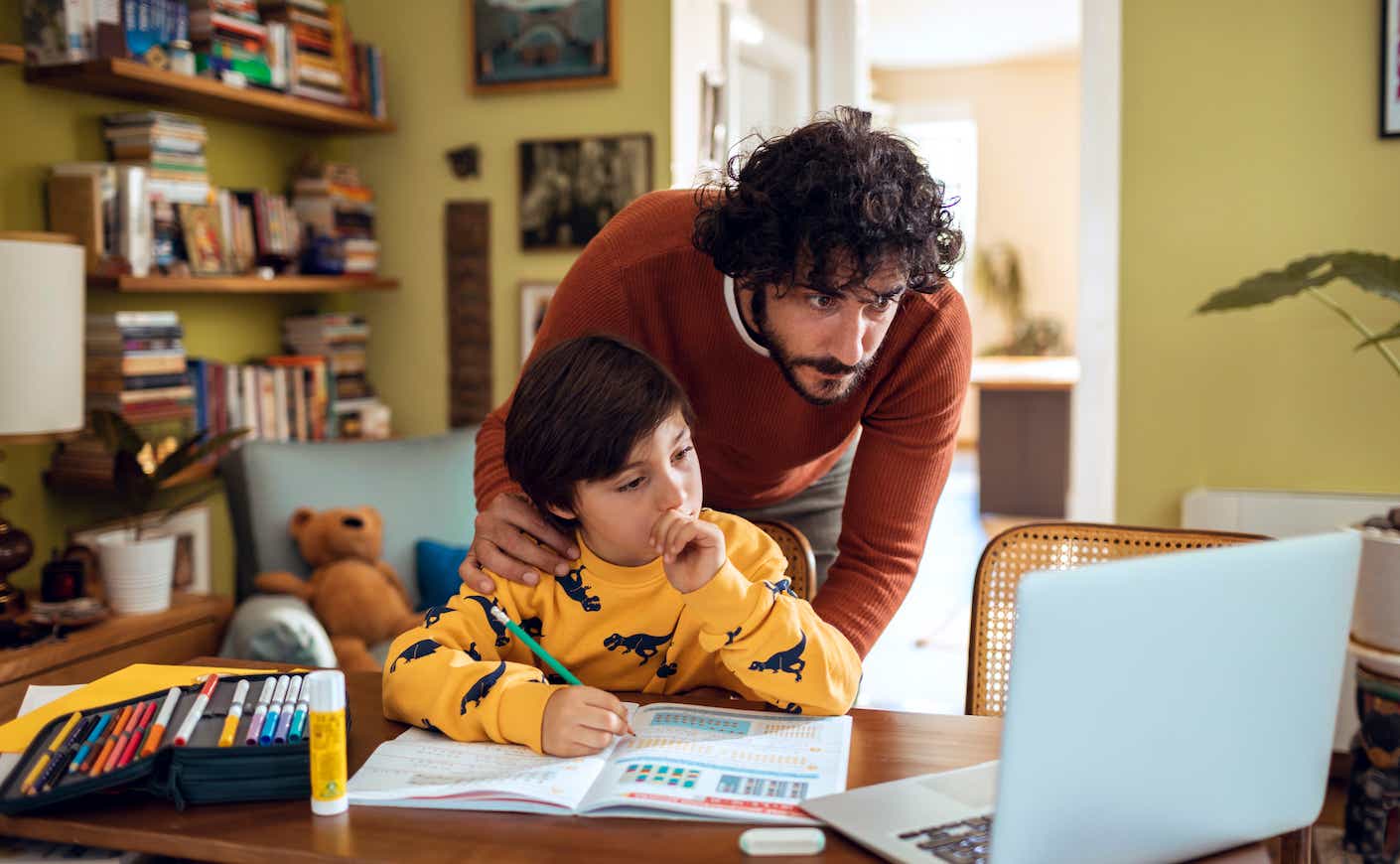Whether you’re a caretaker with a young school-aged child or a parent with a high schooler, you may be facing the stress of juggling homeschooling — along with everything else on your plate — right now. Enter Homeschool Hotline, a new series with our friends at Sleep Number. You’re in luck: Experts from the Child Mind Institute are answering your burning questions about how to make sure your kids aren’t missing out on important learning experiences while maintaining a healthy routine for the whole family. Dr. Amanda Wagner, a clinical neuropsychologist in the Learning and Development Center at the Child Mind Institute, answers this week’s question…
Wake-Up Call: As a parent, how can I make virtual learning more engaging and less monotonous for my kids without creating more work for myself? I’m spread too thin as it is, but I can tell they’re getting bored — and distracted.
Many parents and teachers are reporting noticeable declines in student motivation and engagement right now. Children need more support than ever to navigate these difficult times, yet parents have less time available as they juggle additional roles.
In general, teachers work hard during the school day to maintain students’ attention and engagement. However, many techniques typically used to sustain interest are not available in a remote learning environment. Therefore, the task of maintaining student engagement is either falling to parents or is more heavily dependent on the child’s internal cognitive processes. Children develop the ability to sustain attention to tasks that aren’t as stimulating with age. That means the younger the child, the harder it is for them to maintain their focus without outside help.
It is great to do what you can to support your child’s learning, but don’t feel pressured to take on the additional role of teacher. Here are some straightforward ways to make sure your kids stay engaged with virtual learning…
Set Them Up for Success
Remove any stimuli that might make school more challenging! One common distraction parents report is competing stimuli from screens (for example, YouTube, games, social media and messaging). If needed, use parental controls to ensure that these distractions are restricted, just like they would be in the classroom. Noise-canceling headphones can also help reduce distracting sounds in your child’s work environment.
Use Reinforcement
When a child can’t sustain their attention and engagement on their own, you might need to utilize external reinforcers to increase motivation and participation in class. This can take the form of tangible rewards, attention or even short breaks from tasks (like homework) that they don’t like. By experimenting with different types of reinforcement, you can also add some fun to your days and reduce monotony.
Rewards: Rewards don’t have to be things you buy with money. Talk with your child about different options and let them have input on what they want to earn. Some ideas include special one-on-one time with you, having their favorite meal for dinner, earning minutes to play video games, or getting to choose a movie for family movie night. It’s also a good idea to use a mix of small rewards that are given more frequently (like stickers or tokens) and larger rewards that children can work toward over time. The frequency of rewards will depend on your child’s goals and where they’re starting from. Start with something you are confident they can achieve (like 10 minutes of focusing on homework) and then work to increase the goal over time.
Selective Attention: Your attention is a very powerful tool. Adults often correct misbehavior to discourage it from happening again. But sometimes this might actually have the opposite effect. The child may inadvertently begin to associate that behavior with positive feelings from receiving your attention — even if the attention is negative. Instead, identify the opposite of the misbehavior and reinforce it through use of frequent labeled praise. For example, if you want your child to stop asking you for help with homework when they don’t really need it, try to catch them working independently and praise them for that specific behavior: “I noticed that you studied your spelling words on your own for 10 whole minutes. Amazing job focusing on your work!” Try to use four times as much praise as you do criticism. Letting kids know you appreciate their behavior will make them feel good and when they know exactly what behavior they’re being praised for, they will be more likely to do it again.
Make Sure Your Kids Are Refreshed And Recharged:
Make sure your kids are ready to learn by ensuring they have had a good night’s sleep! It is especially difficult to focus when you are tired. Breaks are also a great way to refresh and recharge, and can also serve as a reward for on-task behavior. For example, you could reward 30 minutes of work with a quick five-minute break. Younger children, especially, often need more frequent short breaks throughout the day.
DEEPER DIVE: The emotional toll of the pandemic has greatly impacted sleep for many people of all ages. The presence of insomnia has increased significantly over the last several months due to growing levels of anxiety. The uncertainty during these times, combined with abrupt changes to normal routines and the lack of social interactions with friends and peers have all led to increased levels of anxiety, and can further generate irregularities with sleeping patterns, mood and overall mental health. One tip? Build time to get outside, every day. Besides being a fun break in the day for your kids, Dr. Judith Owens of Harvard University and the Sleep Number Scientific Advisory Board, says physical activity and exposure to sunlight is very important to circadian rhythms, and can greatly impact the ability for you and your kids to fall and stay asleep.
Model What You Want to See
Most importantly, children look to parents and other adults in their life as role models. Remember to express joy and excitement as you sit down to engage in your work for the day. Additionally, model interest in what they are learning in school. When you ask about their day and are genuinely excited to hear about what they are learning, they will be more likely to be interested in the topic themselves.
And when things get difficult, now more than ever, it’s important to model for kids how to positively cope through challenging times. For example, if you get an unexpected schedule change, show your child that it’s not the end of the world: “I know we just got this change in our schedule. That’s a little stressful. Let’s take some deep breaths together.” That kind of modeling can support social-emotional learning and strengthen your bond with your child.
Dr. Amanda Wagner is a clinical neuropsychologist in the Learning and Development Center at the Child Mind Institute. Find her full bio here.
Dr. Judith Owens is one of the world’s leading authorities on connections between sleep and behavior in children and adolescents. Her work in the field of school start times has changed policies in school districts around the country. Dr. Owens and her colleagues designed the first and now most widely used sleep habits questionnaire for children, which has been translated into over a dozen languages and has been used in over 200 research projects worldwide.













